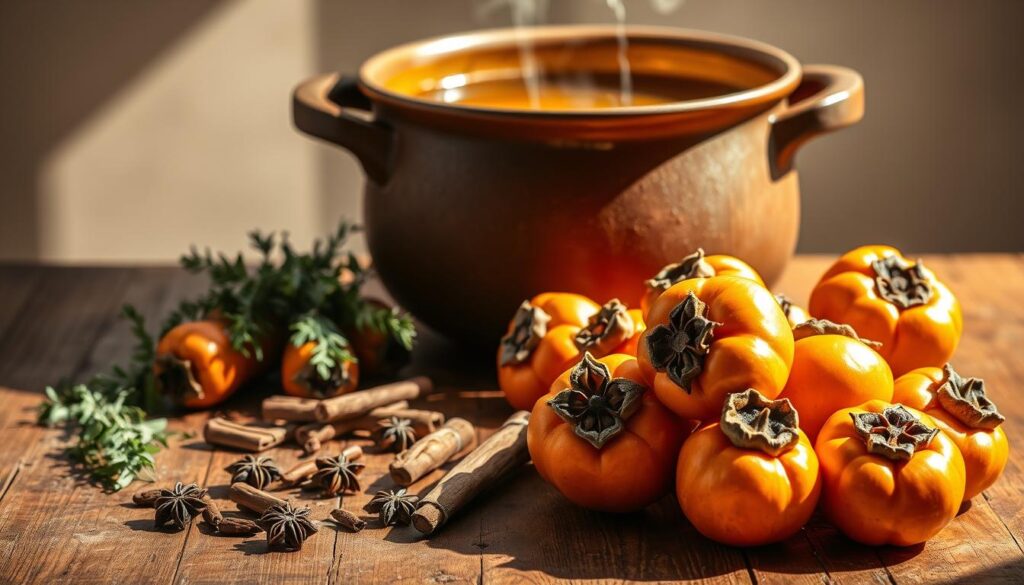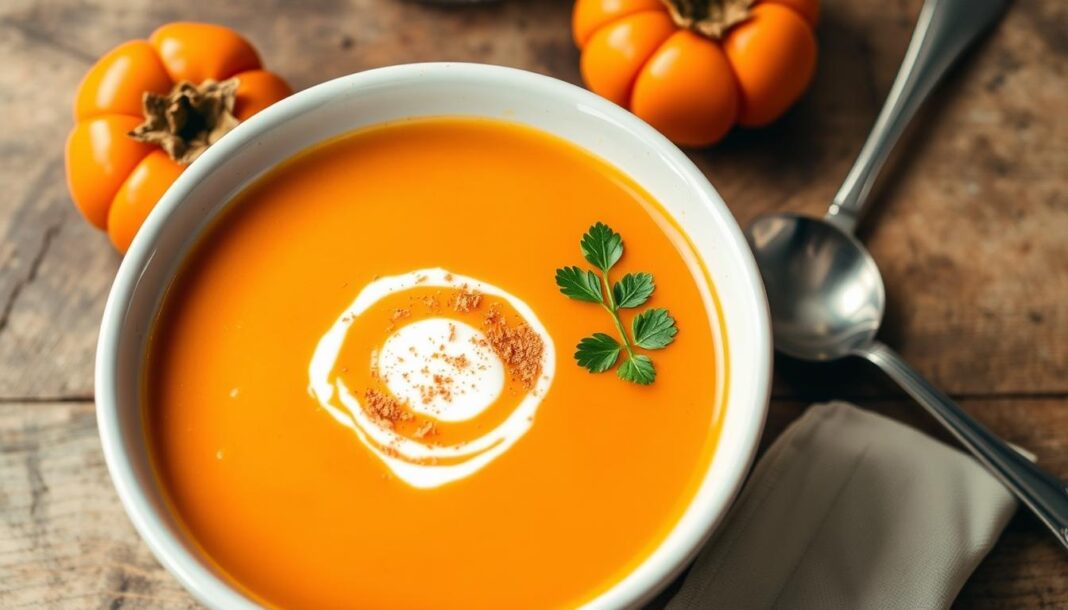As the seasons change, we’re excited to share our expert recipe for a delicious and comforting persimmon soup. This delightful dish showcases the unique flavor profile of persimmons, a fruit that’s often overlooked but perfect for cold weather dining.
We appreciate the brief seasonal availability of persimmons, and our recipe combines their natural sweetness with complementary ingredients to create a balanced flavor. With a preparation and cooking time of approximately 55 minutes, this recipe is feasible for weeknight dinners despite its sophisticated taste.
Key Takeaways
- Our persimmon soup recipe highlights the fruit’s unique sweet-savory profile.
- The recipe works with both fuyu and hachiya persimmon varieties.
- Persimmon soup offers a flavor profile similar to butternut squash soup with distinctive fruity notes.
- The total preparation and cooking time is approximately 55 minutes.
- Understanding persimmon ripeness is essential for optimal flavor and texture.
Essential Ingredients for Perfect Persimmon Soup
The key to a mouth-watering persimmon soup is not just the persimmons themselves, but the array of complementary ingredients that enhance their natural sweetness. At Historical Foods, we’ve perfected our recipe by carefully selecting each component to create a harmonious balance of flavors.
Choosing the Right Persimmons
First and foremost, the quality of the persimmons is paramount. We recommend using ripe, sweet persimmons for the best flavor. The variety of persimmon can affect the soup’s sweetness and texture, so choose accordingly.
Base Vegetables and Aromatics
A tablespoon of olive oil is used for sautéing the base vegetables, which include onions, garlic, and sometimes carrots or celery, imparting a subtle fruity note that complements the persimmons. These aromatics form the backbone of the soup, providing depth and complexity.

Spices and Seasonings
Spices play a crucial role in enhancing the flavor of persimmon soup. We use 1 1/4 teaspoons of ground ginger to add warmth and depth. Additionally, 1/2 teaspoon of turmeric contributes to the soup’s aromatic and slightly earthy notes. A careful balance of salt and freshly ground black pepper is essential for bringing out the complex flavors.
For added depth, consider incorporating small amounts of complementary spices like cinnamon, nutmeg, or allspice—approximately 1/8 teaspoon each. A splash of acid, such as apple cider vinegar or lemon juice (about 1 teaspoon), helps balance the natural sweetness of the persimmons. For those who enjoy a bit of heat, a pinch of cayenne pepper provides a pleasant counterpoint to the soup’s sweetness.
| Ingredient | Quantity | Purpose |
|---|---|---|
| Olive Oil | 1 tablespoon | Sautéing base vegetables |
| Ground Ginger | 1 1/4 teaspoons | Adds warmth and depth |
| Turmeric | 1/2 teaspoon | Contributes aromatic and earthy notes |
| Salt and Black Pepper | To taste | Balances flavors |
Step-by-Step Cooking Method
The cooking process is where the magic happens, transforming our ingredients into a delicious soup. With the ingredients prepared, we can now focus on the technique.
Preparing Your Persimmons
First, we need to prepare our persimmons. We recommend using ripe persimmons for the best flavor. Once they are ripe, peel, core, and chop them into manageable pieces.
Creating the Soup Base
To create the soup base, sauté the base vegetables and aromatics in a pot until they are tender. Then, add the chopped persimmons and enough broth to cover them. Bring the mixture to a boil, then reduce the heat and let it simmer until all the vegetables are tender.
Blending and Finishing Touches
Once all the vegetables are completely tender, remove the pot from the heat and let it cool slightly. We recommend using a high-powered blender to puree the soup in batches, filling the blender no more than halfway to prevent overflow. Alternatively, you can use an immersion blender directly in the pot.
After blending, return the soup to the pot and assess its consistency. If it’s too thick, add additional broth one tablespoon at a time until you reach your desired texture. This is also the moment to season your soup to perfection, adding salt, freshly ground pepper, and potentially a teaspoon of acid (lemon juice or vinegar) to brighten the flavors.
For added depth, consider stirring in a tablespoon of butter or a splash of cream. Then, return the seasoned soup to a gentle simmer for 10-15 minutes to allow the flavors to fully integrate. Finally, taste once more and make any final adjustments to the seasoning before serving.
Serving Your Homemade Persimmon Soup
Serving your persimmon soup is where the magic happens, and we’re here to guide you through it. The key to a delightful serving experience lies in the details, from the garnishes you choose to the accompaniments you serve alongside.
For an elegant presentation, ladle the soup into warmed bowls and garnish with complementary toppings such as a swirl of cream, chopped fresh herbs like parsley or chives, or toasted nuts. A drizzle of high-quality olive oil (about 1-2 teaspoons per serving) not only adds a rich flavor but also creates an attractive finish.
Our persimmon soup is best served immediately after the final simmer, while still hot but not scalding. This allows the complex flavors to be fully appreciated. For a complete meal, consider serving alongside a crusty baguette or artisanal bread for dipping – a combination that’s especially appealing when introducing this unique recipe to first-time tasters.
The soup can be stored refrigerated for up to 3 days, with flavors often developing further over time. For longer storage, allow the soup to cool completely before transferring it to airtight containers and freezing. When reheating, warm gently over medium heat, stirring occasionally, and add a tablespoon or two of chicken broth if needed to restore the original consistency.
Feel free to experiment with this recipe by adding a cup of cooked chicken for a heartier version or a teaspoon of curry powder for an international flavor profile. Pair your persimmon soup with a crisp white wine or apple cider for a complete seasonal dining experience.


